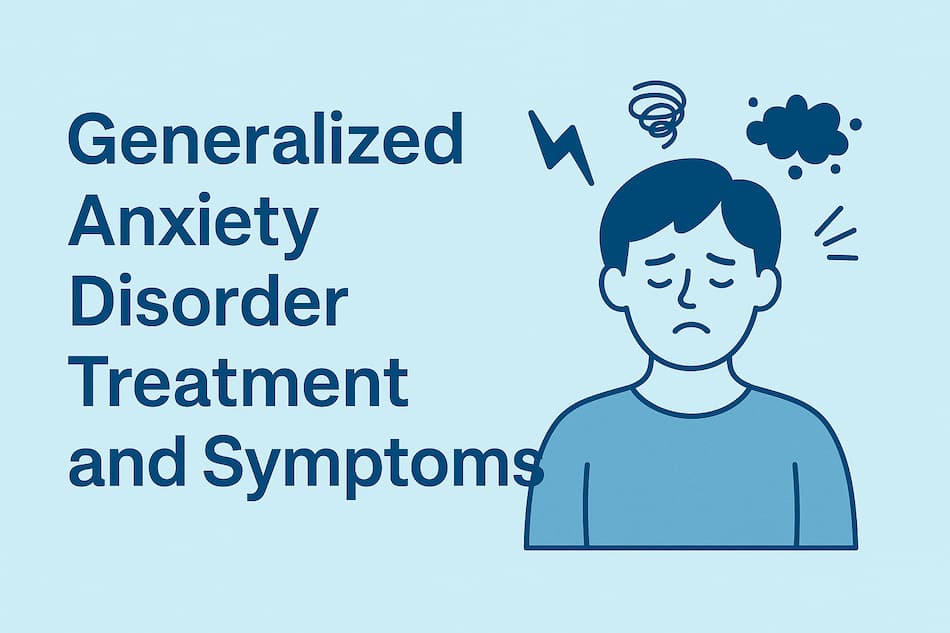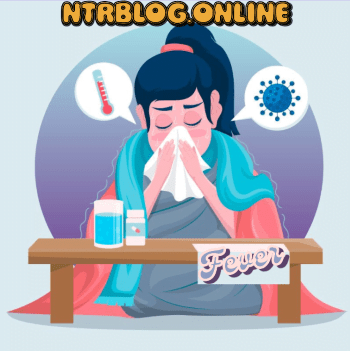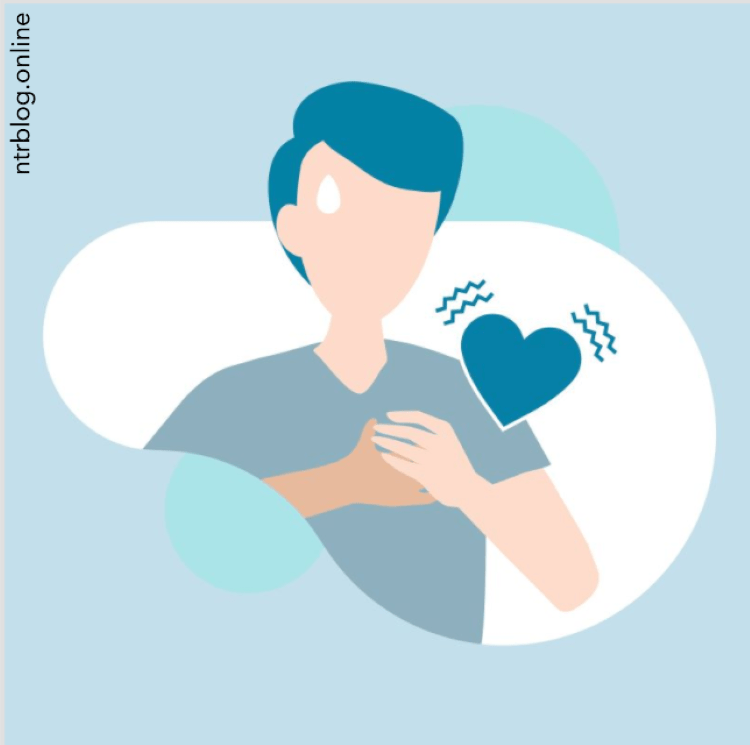Generalized Anxiety Disorder (GAD) is a chronic mental health condition marked by ongoing fear, excessive worry, and a constant sense of being overwhelmed — even when there’s no clear cause. This emotional turmoil can affect both children and adults, making daily tasks feel like mountains.
Table of Contents
🔹 What makes GAD challenging?
It’s not just the mental stress — it’s the way this condition interferes with day-to-day life.
→ Simple activities like working, studying, or maintaining relationships become difficult
→ The worry is persistent and disproportionate, often without any real threat
→ Physical discomfort adds to the burden
What Does Generalized Anxiety Disorder Feel Like?

While it’s completely normal to feel anxious occasionally, especially during life changes or tough times, GAD takes it a step further.
• You may constantly worry about health, money, family, or the future
• These worries occur frequently and intensely, without a clear reason
• The emotional weight is often accompanied by physical symptoms like:
Restlessness or fatigue
Muscle tension or unexplained pain
➡️ These symptoms can severely impact your quality of life and ability to function.
How Common Is GAD?
Around 3% of U.S. adults currently live with GAD
Nearly 5% of people experience it at some point in their lives
Shockingly, only 43% of individuals with GAD receive treatment
Seeking Help Is Essential
If you or someone you know is showing signs of excessive worry, fear, or restlessness, don’t ignore it.
🔸 Effective Generalized Anxiety Disorder treatment and symptoms management often involves:
→ Cognitive behavioral therapy (CBT)
→ Prescription medications
→ Lifestyle adjustments and support
✔️ A mental health professional can help create a personalized treatment plan to reduce the intensity of GAD and bring back balance to life.
Symptoms and Causes of Generalized Anxiety Disorder (GAD)
Generalized Anxiety Disorder (GAD) doesn’t just affect the mind — it takes a toll on the body too. Along with excessive and uncontrollable worry, individuals often experience physical symptoms that can disrupt daily life.
Let’s break down the most common Generalized Anxiety Disorder treatment and symptoms for better understanding.
Common Emotional & Mental Symptoms
People living with GAD often feel emotionally drained due to:
• Persistent, excessive worry about routine events or activities
• Difficulty controlling the anxiety or stopping the negative thoughts
• Anxiety episodes that come and go, especially under stress
Physical Symptoms of Generalized Anxiety Disorder
Chronic anxiety doesn’t stay in the mind alone — it spills over into the body. Here are the most common physical signs:
→ Trouble falling or staying asleep
→ Constant fatigue, even after resting
→ Irritability or feeling on edge
→ Headaches and muscle tension
→ Rapid heartbeat or heart palpitations
→ Shortness of breath and chest tightness
→ Sweating and restlessness
→ Difficulty concentrating or staying focused
→ Unexplained aches — like stomachaches or body pain
💡 These Generalized Anxiety Disorder treatment and symptoms should not be ignored. The earlier the condition is managed, the easier it becomes to regain control over your life.
What Causes Generalized Anxiety Disorder?
There’s no single cause behind GAD. Instead, it’s believed to result from a combination of factors:
🔸 Brain Function
→ Some people process stress and worry differently due to brain chemistry imbalances (like serotonin, dopamine, and GABA).
🔸 Genetics
→ GAD may run in families. If a close family member has it, your risk increases.
🔸 Life Experiences
→ Childhood trauma, chronic stress, or major life events can contribute to the development of GAD.
Risk Factors of GAD
You might be more likely to develop GAD if you:
• Are female
• Have a family history of anxiety disorders
• Faced childhood abuse or trauma
• Are living with other mental health issues (like depression or phobias)
• Regularly use substances like alcohol, tobacco, or marijuana
• Manage a chronic illness or physical condition
➡️ GAD can begin in childhood, adolescence, or adulthood — and sometimes without any warning.
Possible Complications of GAD
When left untreated, GAD can lead to more severe complications such as:
→ Substance use disorder
→ Mood swings and energy imbalances
→ Suicidal thoughts or self-harming behavior
⚠️ If you or someone you know is in crisis, don’t wait. Call or text 988 — the Suicide & Crisis Lifeline (U.S.). Help is available 24/7.
Diagnosis and Tests for Generalized Anxiety Disorder (GAD)
Diagnosing Generalized Anxiety Disorder (GAD) involves more than just recognizing excessive worry — it’s a step-by-step evaluation of mental, emotional, and physical health.
A healthcare provider — often your primary care doctor — may refer you to a mental health specialist such as a psychologist or psychiatrist. These experts assess both your symptoms and your personal history to provide the best guidance.
How Is GAD Diagnosed?
Here’s what the diagnosis process typically looks like:
→ A conversation about your emotional and physical health
→ Discussion of your mental health and medical history
→ Observation of your behavior, facial expressions, and speech patterns
→ A GAD-7 questionnaire to assess anxiety severity
Additional tests may also be ordered to rule out medical conditions that mimic anxiety:
• Blood tests (to check thyroid function, glucose levels, or substance use)
• Echocardiogram (to evaluate heart function if palpitations are present)
Diagnostic Criteria for Generalized Anxiety Disorder
Doctors use the DSM-5-TR (Diagnostic and Statistical Manual of Mental Disorders) to confirm a GAD diagnosis. The official criteria include:
🔸 Feeling anxious or excessively worried most days for at least six months
🔸 The worry is difficult to control and disrupts everyday life
In adults, three or more of the following symptoms must be present (children need only one):
→ Restlessness or feeling keyed up
→ Fatigue or getting tired easily
→ Difficulty concentrating or mind going blank
→ Irritability
→ Muscle tension
→ Trouble sleeping or unrefreshing sleep
💡 These Generalized Anxiety Disorder treatment and symptoms must also interfere with your ability to work, socialize, or maintain a healthy lifestyle.
Ruling Out Other Conditions
Your provider will ensure that the symptoms are not caused by:
• Medication side effects
• Substance use
• Other mental health disorders such as:
Panic disorder
Social anxiety
Obsessive-compulsive disorder (OCD)
Post-traumatic stress disorder (PTSD)
➡️ A proper diagnosis is the first and most crucial step toward managing Generalized Anxiety Disorder treatment and symptoms effectively.
Management and Treatment of Generalized Anxiety Disorder (GAD)
When it comes to managing Generalized Anxiety Disorder treatment and symptoms, a customized approach that includes both therapy and medication often delivers the best results. Each person’s experience with GAD is unique, so your healthcare provider will design a treatment plan that suits your individual needs and health condition.
Psychotherapy – Talk Therapy for GAD
Psychotherapy, or talk therapy, is one of the most effective tools to treat GAD. In this process, a licensed mental health expert helps you explore your thoughts, emotions, and behaviors in a safe and supportive environment.
The most widely recommended form of therapy for GAD is:
🔹 Cognitive Behavioral Therapy (CBT)
→ Helps identify and challenge negative thought patterns
→ Teaches healthier ways to respond to anxiety triggers
→ Builds long-term coping strategies and emotional resilience
✅ Over time, CBT helps reduce excessive worry and promotes long-term stability in managing Generalized Anxiety Disorder treatment and symptoms.
Medications Used to Treat GAD
In many cases, medications are prescribed either alone or alongside therapy. Your provider may consider the following drug options based on the severity of your symptoms:
• SSRIs (Selective Serotonin Reuptake Inhibitors)
Examples: Escitalopram, Paroxetine, Sertraline
• SNRIs (Serotonin-Norepinephrine Reuptake Inhibitors)
Examples: Duloxetine, Venlafaxine
• Benzodiazepines (short-term use only)
• Buspirone – a non-sedative anti-anxiety medication
➡️ If these first-line medications don’t work, second-line options include:
• Tricyclic antidepressants (e.g., Amitriptyline)
• Second–generation antipsychotics
• Valproate (used cautiously)
⚠️ Medication should always be monitored by a healthcare provider to manage side effects and adjust dosage as needed.
When to Contact Your Healthcare Provider
It’s important to stay in regular contact with your provider, especially if:
→ You’re starting or adjusting medication
→ You experience unwanted side effects
→ Your symptoms worsen or change
→ You feel emotionally overwhelmed or unsafe
💡 Therapy may take time to show full results — consistency is key! If you miss a session, try to reschedule it and stay committed to your recovery journey.
🚨 In case of severe distress or suicidal thoughts, don’t wait — call 911 or your local emergency number immediately.
Outlook and Prognosis for Generalized Anxiety Disorder (GAD)
Living with Generalized Anxiety Disorder doesn’t mean your quality of life has to suffer forever. While GAD can be a long-term mental health condition, the outlook improves significantly with proper care and consistency.
Everyone experiences GAD differently. On some days, your symptoms may feel overpowering — especially during stressful periods. On other days, you may feel calm and more in control. The key lies in finding a personalized plan that works for you.
What to Expect with GAD
➡️ With the right combination of support, Generalized Anxiety Disorder treatment and symptoms can be managed effectively. Here’s what you can expect:
• Treatment helps reduce the intensity and frequency of symptoms
• Therapies and medications can improve daily functioning
• Coping strategies make you more resilient over time
• Your care team will adjust your treatment as your needs evolve
💡 GAD may not disappear completely, but it doesn’t have to define your life.
Self-Care Tips to Manage GAD
In addition to medical support, lifestyle changes play a major role in managing Generalized Anxiety Disorder treatment and symptoms. Small steps can lead to big results:
🔹 Make Mindful Lifestyle Changes
→ Reduce caffeine and alcohol intake
→ Spend less time on social media
→ Get quality sleep and maintain a balanced diet
→ Stay socially connected with loved ones
→ Engage in regular physical activity
🔹 Practice Relaxation Techniques
• Meditation
• Deep breathing exercises
• Yoga and guided imagery
• Progressive muscle relaxation
🔹 Avoid Addictive Substances
→ Smoking, alcohol, or recreational drugs may worsen anxiety and interfere with medication effectiveness.
🔹 Seek Support
→ Join a support group — online or in person — to share your journey, find encouragement, and learn from others.
🔹 Use Mental Health Apps
→ Many free or paid apps can help you:
• Track your mood
• Build healthy habits
• Practice daily coping skills
• Stay motivated
Remember: You are not alone in your journey. With the right guidance and support system, living a balanced and fulfilling life — even with GAD — is absolutely possible. 🌿
Frequently Asked Questions (FAQs) About Generalized Anxiety Disorder (GAD)
1. What is Generalized Anxiety Disorder (GAD)?
Generalized Anxiety Disorder (GAD) is a mental health condition that causes ongoing, excessive worry about everyday life situations. It often affects how a person thinks, feels, and functions daily. People with GAD may also experience physical symptoms like fatigue, restlessness, and muscle tension.
2. What are the most common symptoms of GAD?
Common symptoms include:
→ Excessive and persistent worry
→ Difficulty concentrating
→ Irritability and muscle tension
→ Sleep problems and fatigue
These symptoms can vary in intensity and are often worse during periods of stress. Early recognition of Generalized Anxiety Disorder treatment and symptoms can help in effective recovery.
3. How is Generalized Anxiety Disorder diagnosed?
A mental health professional typically diagnoses GAD using psychological evaluations, mood questionnaires (like GAD-7), and medical history analysis. According to DSM-5-TR guidelines, the anxiety must be present most days for at least six months and interfere with daily functioning.
4. What are the treatment options for GAD?
The best results come from a combination of psychotherapy (especially Cognitive Behavioral Therapy) and medications like SSRIs or SNRIs. Your provider will tailor a plan suited to your lifestyle and health status. Consistency in treatment is key to managing Generalized Anxiety Disorder treatment and symptoms.
5. Can lifestyle changes help manage GAD?
Yes, lifestyle plays a crucial role. Practices like:
• Regular exercise
• Healthy sleep habits
• Reducing caffeine and alcohol
• Mindfulness and meditation
• Connecting with support groups
…can all enhance the effects of professional treatment and improve day-to-day well-being.
Summary of Generalized Anxiety Disorder treatment and symptoms
Generalized Anxiety Disorder (GAD) is a long-term mental health condition characterized by persistent and excessive worry about daily life situations. It can affect both the mind and body, leading to symptoms such as restlessness, fatigue, headaches, and difficulty concentrating.
Timely recognition and appropriate intervention can make a significant difference. The most effective approach to managing Generalized Anxiety Disorder treatment and symptoms includes a combination of psychotherapy, especially Cognitive Behavioral Therapy (CBT), medications, and lifestyle adjustments.
By understanding the causes, recognizing the symptoms, and following a personalized treatment plan, individuals can regain control over their lives and significantly improve their overall well-being. Whether through therapy, medication, or self-care techniques, support is available — and recovery is possible.



